OK, so Boy’s Cinema wasn’t actually a comic. It was a weekly story-paper that specialised in prose adaptations of then-current movies. It was very popular in its heyday, many decades before Netflix and Blockbuster and the movie novelisations from the 1970s and 80s, all of which were written by Alan Dean Foster.
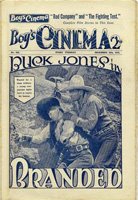 Boy’s Cinema
Boy’s Cinema
From: 13 December, 1919
To: 18 May, 1940
Duration: 20 years, 5 months
Issues: 1063
Absorbed: Screen Stories, Boys’ Broadcast, Modern Boy (1938)
The paper was initially called Boys’ Cinema Weekly, but at some point between issue #337 (May 1926) and issue #532 (Feb 1930) the apostrophe was nudged back one place from possessive plural to possessive singular, and shortly after that the “Weekly” was dropped, leaving it as Boy’s Cinema.
The cinema-going experience in those days was very different to today: you got a main feature and a less-important second feature, a news reel, a couple of cartoons, and an episode of a multi-part serial. For the most part, the movies chosen for adaptation in Boy’s Cinema were those aimed at young men and covered both of the movie genres considered acceptable to that audience: Cowboys and Detectives. They were generally the second features, the B-movies… relatively low budget, few big-name actors, short running-time, not expected to turn a huge profit.
With an issue-count of 1063, and three to four movie adaptations per issue, that’s an awful lot of six-guns, treacherous dames, ranch-hands, fedoras and snappy dialogue along the lines of “Why, I oughta…”
Along the way the paper absorbed Boys’ Broadcast (27 Oct 1934 to 29 Jun 1935, 36 issues), Screen Stories (8 Feb 1930 to 17 Aug 1935, 289 issues) and Modern Boy (19 Feb 1938 to 14 Oct 1939, 87 issues), but it eventually succumbed to the dreaded paper shortages of the second world war (as I mentioned in the Hatch, Match & Dispatch column for May 2020).
Today, we’re looking at issue #1008, cover-dated 8 April 1939, carefully selected based on the criteria that it’s the only copy I own.
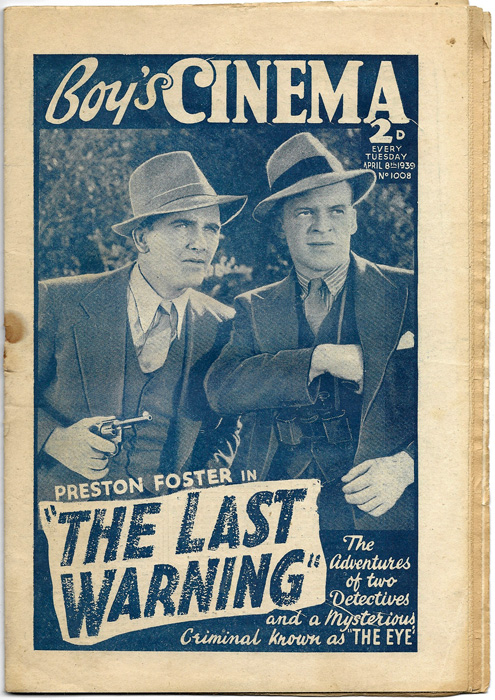
It’s a twenty-eight page publication, the pages approximately 190mm by 275mm (in imperial, that’s about seven and sixty-one one hundred and twenty-fourths inches by eleven and a smidge inches), fairly cheap newsprint bound by a single staple. Except that the staple that was originally holding my copy together has long since disintegrated into rusty dust, all that remains of it now is a collection of stains and little holes.
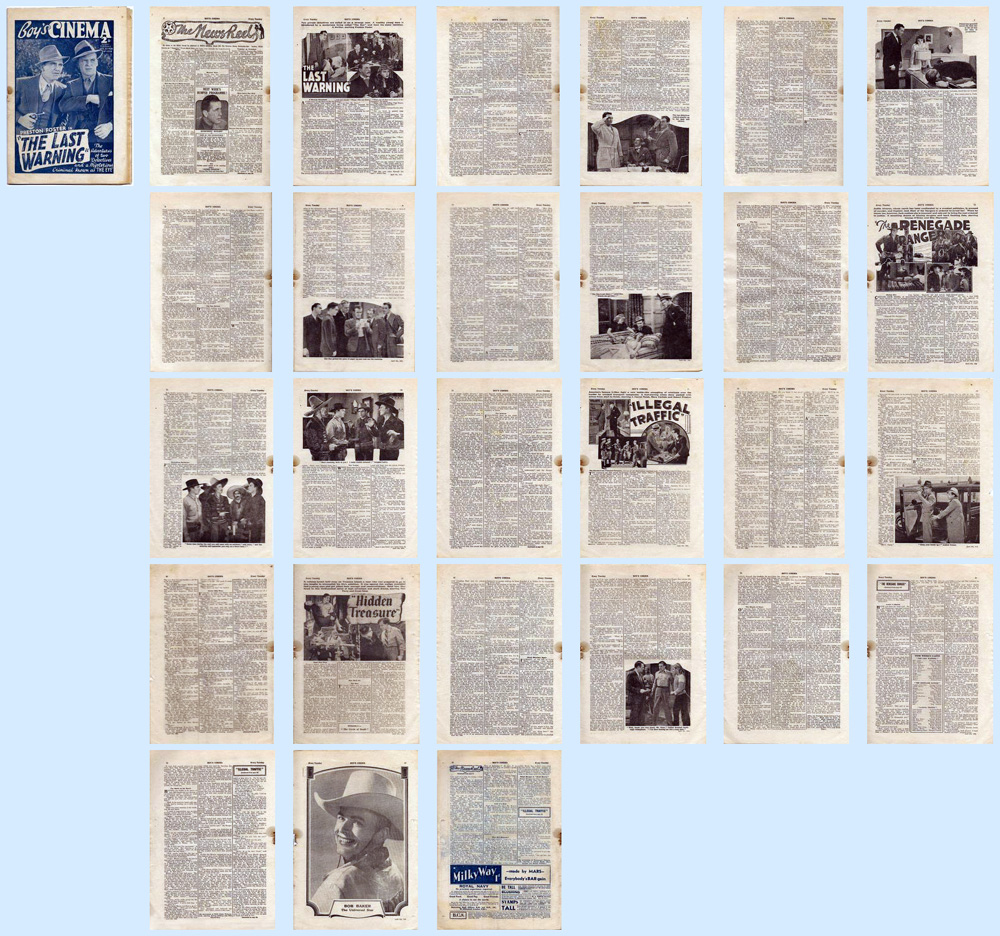
So, as you can see, there’s a lot of text there… Using my best skill and judgement I’ve calculated the number of words per story (to within an error margin of 0.00001%, based on the principle of “who’s going to check?”) so you’ll be able to tell how much value your ancestors got for their two pennies.
Here’s how the calculations were calculated… First, I ran an optical character recognition process on page 4, which is all solid text. Once I’d cleaned up the text, that gave me a word-count of 1577, or 525.666 words per column. Each column on page 4 measures 232mm, so from that we can calculate that on average we’re looking at 2.27 words per millimetre.
The body text of The Last Warning measures as follows (each page contains three columns of identical lengths):
Page 3: 115mm x 3 = 345mm
Page 4: 232mm x 3 = 696mm
Page 5: 138mm x 3 = 414mm
Page 6: 232mm x 3 = 696mm
Page 7: 130mm x 3 = 390mm
Page 8: 232mm x 3 = 696mm
Page 9: 138mm x 3 = 414mm
Page 10: 232mm x 3 = 696mm
Page 11: 128mm x 3 = 384mm
Page 12: 232mm x 3 = 696mm
Add them all up and it comes to… 5,427mm (or about average height for an adult giraffe). Multiply that by 2.27 words per millimetre and we get 12,319.29 words, which of course we round down. I repeated the process for each story in the paper.
 1. Front Cover
1. Front Cover
Features a still from The Last Warning that was used as part of one of the movie’s posters, which I’ve helpfully tracked down for you here. Note the liberal use of the noble airbrush to render those stunningly life-like skin-tones on stars Preston Foster and Frank Jenks.
2. The News Reel — 2,009 words (885mm)
Movie news! This week: Carol Ann Beery — who recently made her screen debut in China Seas — gives advice on on-screen hugging. Will Hay wants to buy a water cruiser. Having played the role of orchestra leader in twenty-three movies, actor Phillip Terry is about to set up his own orchestra. Arthur Treacher, who’s famously played many on-screen butlers, has been made an Honorary President of the Butlers’ Club. There are details on the new British Gene Autry Fan Club. Extra-turned-actor Dennis O’Keefe promises not to let success go to his head. And the Next Week box informs us that the next issue will contain adaptations of Humphrey Bogart crime-caper King of the Underworld and John Wayne western Pale in the Saddle, along with another grand episode of Hidden Treasure. The news is continued on page 28… see you there!
3-12. The Last Warning — 12,319 words (5,427mm)
Based on the 1939 movie of the same name, which in turn was based on the 1938 novel of a different name: The Dead Don’t Care by Jonathan Latimer. Detectives Bill Crane (Preston Foster) and “Doc” Williams (Frank Jenks) investigate mysterious dastardly goings-on at a wealthy country estate, but their irreverent attitude and maverick style don’t sit well with everyone, and threaten to impede their investigation.
This hard-boiled detective story is the third (and last) movie adapted from Latimer’s William Crane books, and it’s absolutely packed with cliches… but it’s important to remember that it was written before a lot of them became cliches. There’s some terribly corny dialogue and prose here, but a few rather good lines too. Judge for yourself whether this passage contains the former or the latter:
The two detectives dived in and went splashing across the pond. The fair girl swam alongside the mattress, held on with one hand and surveyed the newcomers with an air of inquiry.
“Don’t think I’m fresh,” said the lady, ”but I don’t seem to recall either of you.”
“I’m a man named Crane,” answered the detective, in his easy manner. “I was in the neighbourhood so I just dropped in for a quick week-end.”
“My name is Dawn Day,” confided the fair girl.
The dark girl eyed the two men and then suppressed a slight yawn. The detectives talked for a while until the dark girl went to sleep and the fair one swam away. It was then that Crane noticed that the veranda near the rose garden now had two occupants, a girl and a man. He whispered to Doc that he was going to do some more investigating.
Now, I’ve not seen the movie so I don’t know whether dialogue like “I’m a man named Crane” comes from this adaptation, the movie, or the book upon which it was all based, but by all that’s gum I want to see this movie right now!
13-16. The Renegade Ranger — 6,438 words (2,386mm)
 A western! George O’Brien plays the wonderfully-named Jack Steele, a Texas Ranger who’s been assigned to arrest Judith Alvarez, a former ranch owner wanted for murder. But the truth is Alvarez (played by Rita Hayworth) has been framed, and she now leads a dangerous gang of vigilantes trying to out-wit corrupt government officials who’ve been swindling the local farmhands out of their land. This is classic pot-boiler stuff, packed with gripping scenes and unforgettable dialogue…
A western! George O’Brien plays the wonderfully-named Jack Steele, a Texas Ranger who’s been assigned to arrest Judith Alvarez, a former ranch owner wanted for murder. But the truth is Alvarez (played by Rita Hayworth) has been framed, and she now leads a dangerous gang of vigilantes trying to out-wit corrupt government officials who’ve been swindling the local farmhands out of their land. This is classic pot-boiler stuff, packed with gripping scenes and unforgettable dialogue…
Sanderson’s eyes flicked. He dropped his hands and turned to the safe. Scowling, he took from it some money bags and tossed them to the old Spaniard.
“Thank you, Mr. Sanderson,” the girl said drily. “On my next visit I shall leave you a receipt.”
17-20. Illegal Traffic — 5,550 words (2,445mm)
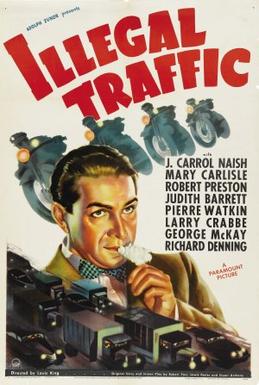 Robert Preston plays Federal agent Bent Martin — yes, his first name really is Bent, which I expect is short for something like Bentjamin or maybe Bentgomery — who’s on a mission to infiltrate a shipping company that’s been smuggling crooks across the border, and taking a hefty share of their ill-gotten gains as payment.
Robert Preston plays Federal agent Bent Martin — yes, his first name really is Bent, which I expect is short for something like Bentjamin or maybe Bentgomery — who’s on a mission to infiltrate a shipping company that’s been smuggling crooks across the border, and taking a hefty share of their ill-gotten gains as payment.
Luckily, Bentolomew had previously worked as a pilot so he manages to persuade the gang that they need him for that purpose… but along the way he falls for Carol Butler, a gangster’s daughter played by Mary Carlisle. Of particular interest to comics geeks is another of the movie’s actors, former Olympic swimmer Larry Crabbe, better known as “Buster” Crabbe, AKA both Flash Gordon and Buck Rogers.
Bent Martin drove the car along the dark road. By his side sat Zomar.
“Pull over in among those trees,” said Zomar after a while. “We’ll wait there for the milk truck.”
Martin did so. Things would happen any moment now, and he wondered vaguely what they would be. Ten minutes passed, twenty, thirty; then suddenly he saw lights approaching, and with a clatter the milk van came rushing by.
21-24. Hidden Treasure — 4,985 words (2,196mm)
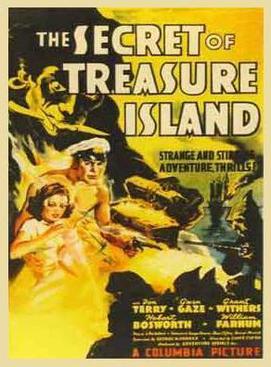 Episode 8: “The Circle of Death”
Episode 8: “The Circle of Death”
A multi-part story appropriately adapted from a movie serial, in this case The Secret of Treasure Island, starring Don Terry and Gwen Gaze, which was a loosely-adapted and updated version of Robert Louis Stevenson’s Treasure Island.
This was actually one of the better-regarded movie serials of the time, but in recent decades has achieved some notoriety mostly because the serial’s story was written by L. Ron Hubbard, founder of Scientology.
Ignorant of the fate of Larry Kent, wondering with feverish anxiety whether Collins had intended to harm him in any way, Toni Morell spent in that room wherein she had been locked two of the most unpleasant hours she had ever experienced.
A whole eternity seemed to drag by in the space of those two hours, and, now hunched wretchedly in a chair, now walking to and fro in an aimless and distracted fashion, she was engaged in one of her agitated perambulations back and forth across the room when all at once a slight sound diverted her attention to a great portrait that hung upon one wall of the apartment.
25-26. The Renegade Ranger, continued from page 16
26 Illegal Traffic, continued from page 20
27. Bob Baker Pin-Up
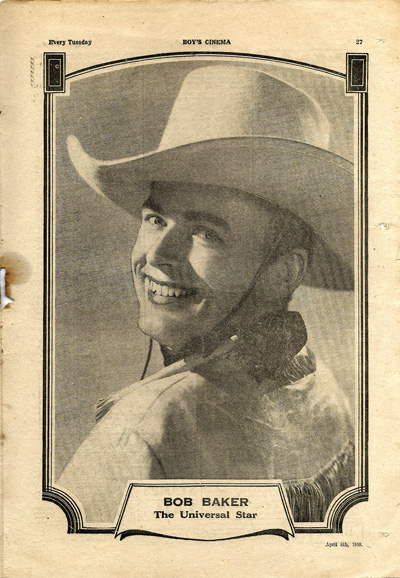
28. The News Reel, continued from page 2
In this second portion of news we hear more from Dennis O’Keefe, learn that Nigel Bruce (Dr. Watson in the Sherlock Holmes movie The Hound of the Baskervilles) carries a lucky charm at all times: a medallion carved from ivory, thirteen-year-old orphan Linda Ware has been signed to star alongside Bing Crosby in The Star Maker, and Ralph Morgan has been signed to play General John Steele in the upcoming movie The Great Enemy (also appearing in that movie will be Preston Foster, whom of course we all know from the classic detective caper The Last Warning).
So that’s Boy’s Cinema. Assuming that this issue is typical of the paper’s contents, then for your tuppence you get 31,301 words, not counting the ads and such. That’s 15,650½ words per penny, which is really good value. When The Great Gatsby was launched in the USA in 1925, it cost $2.00, which at the time was equivalent to about forty pence in the UK. At a word-count of 47,094 (it’s a very short book), that comes to about 1,177.35 words per penny.
From this valuable info, we can conclude that a copy of Boy’s Cinema was over thirteen times better value than F. Scott Fitzgerald’s famous novel, but they don’t teach you things like that in school.
Bonus:
The back page also contains the story-paper’s only ads…
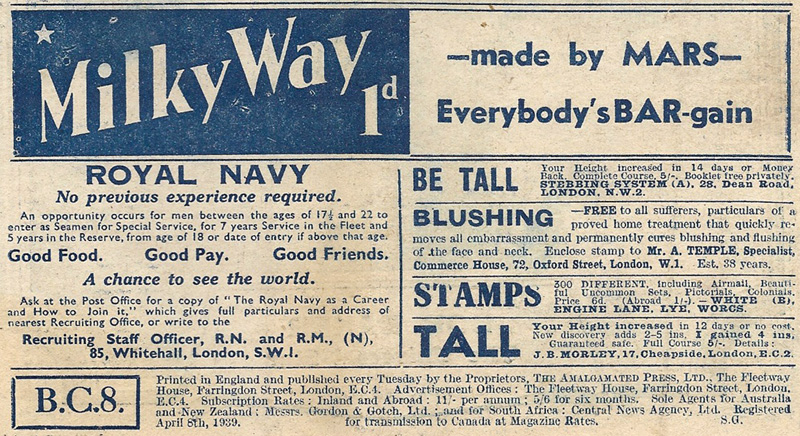
You don’t get a lot of ads for height-enlargement or blush-banishment these days. Or the Royal Navy, come to think of it. But Milky Way bars are still available, so at least some things remain constant.

I have a very shallow knowledge of British comics history but I like to think that I would at least recongise the majority of titles, even if I haven’t ever seen them myself, and yet you consistently turn up fascintating relics that I’ve never even heard of. More power to your scrivening elbow sir!
LikeLike